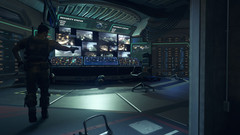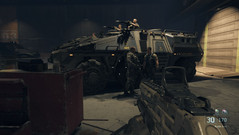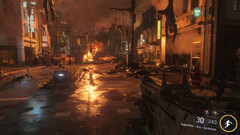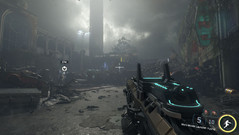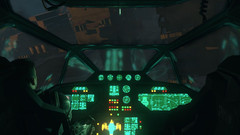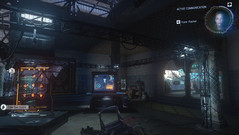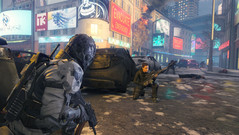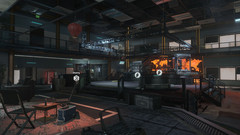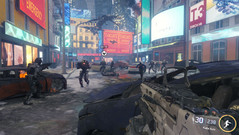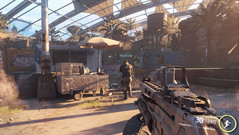Call of Duty: Black Ops 3 Notebook Benchmarks
For the original German article, see here.
Graphics
After the overhasty release of the graphically premature Batman: Arkham Knight, the next AAA game came onto the market on November 6th, 2015. Once again, the title gives the PC platform a bad rap. The biggest con proves to be the game's unstable performance. Even on uber-powerful hardware, some levels and game situations stutter heftily for untraceable reasons, and reducing the settings doesn't solve the problem.
Computers with graphics cards that lack VRAM are especially prone to these performance drops. For example: Even though its overall performance is higher, the desktop version of the GTX 980 stuttered worse than its notebook counterpart, the GTX 980M, which is equipped with 8 GB of video memory rather than 4. When it comes to weaker models that hit their performance limits earlier, the discrepancies aren't quite as pronounced.
Black Ops 3 seems very poorly optimized for working memory as well. When we opened the Task Manager for testing purposes, we were astonished to see that the first-person shooter was gobbling all 8 GB of our desktop PC's memory. Speaking of switching windows: On some systems the screen went completely black after settings changes or immediately after the game startup, though we could still hear the sound in the background. In such cases, briefly exiting Full-screen Mode via Alt + Enter often resolved the problem. The game occasionally froze completely, however, forcing us to kill the EXE through the Task Manager.
Yet that's not all: Over the course of our tests, we also dealt with mouse bugs (after changing the resolution on our 4K monitor), graphics errors (mostly at low and medium detail settings), and strange fluctuations in load time. While most games' load times are dependent on the system's mass storage device (SSD vs. HDD), Black Ops 3 seems to be influenced by the potency of the other hardware as well.
Now, one could argue that a visually stunning first-person shooter is simply bound to eat up resources. But in our experience, the hardware demands and graphics quality aren't strictly related. With the exception of the detailed and well-animated characters, the game's visuals aren't especially impressive. During the campaign, the player often encounters muddy textures and second-rate effects (fire looks somewhat pathetic). True, Black Ops 3 has considerably more game physics elements than its predecessor, but overall the graphics seem somewhat antiquated. This makes the performance problems and bulky game size (almost 50 GB download) all the more irritating.
In terms of gameplay, buyers will get that familiar Call of Duty feeling: Diverse kinds of action in perfectly-tailored scenes. But under the hood, we discover that it's more about appearances than substance: The game is plagued with poorly executed AI, excessively large enemy waves and a chaotically-presented story. Nor does the game require much in the way of strategy in single-player mode, and the difficulty level is disappointing.
But back to the graphics: In some instances, the title certainly deserves praise. While we criticized Advanced Warfare for the frustrating experience of scrolling through the graphics menu, Black Ops 3's design is substantially cleaner here. The graphics settings are divided into two tabs: "Video" includes the basic options like resolution, brightness and field of view, while "Advanced" allows the user to make adjustments to the features.
Black Ops 3 utilizes numerous modern technologies like subsurface scattering and volumetric lighting. All in all, the two menus contain more than 20 options - a very broad array for a PC game. Excellent: Alongside anti-aliasing, the user can also change the maximum frame rate. The latter runs from 24 to 240. The game also offers Vsync, which prevents image tearing.
We are even more pleased to report that all settings can be applied without restarting (even while the game is running). There do appear to be some small bugs remaining, though. In our tests, some options (ex. anti-aliasing and ambient occlusion) weren't always correctly saved, forcing us to visit the graphics menu two or three separate times. It was also somewhat aggravating that the mouse speed is contingent on the general performance, and in extreme cases the menus were impossible to use. (On the plus side, it's immediately clear when a setting overloads the system.)
Shortly after the title's release, many buyers also complained about the performance of dual-core processors. Intel's Core i5 models have cropped up especially frequently in this context. However, because we ran all the benchmarks with the first patch (released on the game's launch day), we hardly encountered this problem.
Benchmark
Although Black Ops 3 needs quite some time to load a level (the videos don't stutter on weaker devices as badly as they did previously), measuring frame rates was fairly easy. Finding a fitting sequence was a more difficult task. The user is permitted to unlock all of the missions at the first startup (we wish the competition would copy the developer here), but because of the massive performance drops many levels are out of the question.
To guarantee a high degree of comparability, we also had to eliminate missions whose course is hard to reproduce. To cut a long story short: In the end, we chose the beginning of the third chapter, "In Darkness". Yes, as the video reveals, the sequence isn't particularly spectacular (no gunfight, etc.), but the performance fluctuations in other scenes were simply too vast to allow for an accurate GPU ranking.
Because the frame rate varies greatly depending on the mission and platform, the player will need some additional performance capability to fall back on when the going gets tough. That is to say: In order for a system to render Black Ops 3 reasonably fluidly, it will need to reach at least 50 or 60 fps in the benchmark sequence. Even then, over the course of the game the player is bound to be confronted with some serious stuttering now and then. As a result, the following results and assertions can only be regarded as a rough guide. The developers at Treyarch certainly have their work cut out for them. Only time will tell whether Black Ops 3 will ever run smoothly on PCs - it may very well share the same fate as Arkham Knight.
Results
Owners of budget or office notebooks can stuff their 60 Euros (~$65) back in their pockets. Low-end GPUs, like Intel's HD Graphics 4600, and older/cheaper mid-range chips, like the GeForce GT 740M, can't even run Black Ops 3 at low details and 1024x768 pixels. These low settings demand at least a GTX 850M. Normal details and 1366x768 pixels require a bona-fide gaming GPU (for instance the GTX 960M or GTX 870M).
For high detail settings and 1920x1080 pixels, a GTX 970M is the first sensible choice. The same goes for maximum settings, which are only accessible to the technological crème de la crème. 4K kicks every notebook GPU's derrière. Even the desktop GTX 980 stutters like mad at 3840x2160 pixels and the "High" setting.
| Call of Duty: Black Ops 3 | |
| 3840x2160 High / On AA:FX 1920x1080 Extra / On AA:T2x SM 1920x1080 High / On AA:FX 1366x768 Medium / Off 1024x768 Low / Off | |
| AMD Radeon R9 290X, 4790K | |
| NVIDIA GeForce GTX 980, 3770K | |
| NVIDIA GeForce GTX 980M, 4700MQ | |
| AMD Radeon R9 280X, 4790K | |
| NVIDIA GeForce GTX 970M, 4700MQ | |
| NVIDIA GeForce GTX 950, 3770K | |
| AMD Radeon R7 370, 3960X | |
| NVIDIA GeForce GTX 880M, 4700MQ | |
| NVIDIA GeForce GTX 870M, 4700MQ | |
| NVIDIA GeForce GTX 960M, 4720HQ | |
| NVIDIA GeForce GTX 850M, 4340M | |
| NVIDIA GeForce GTX 860M, 4700MQ | |
| AMD Radeon R7 512 Cores (Kaveri Desktop), A10-7850K | |
| NVIDIA GeForce GT 750M, 4702MQ | |
| Intel Iris Pro Graphics 5200, 4750HQ | |
| NVIDIA GeForce GT 740M, 4200M | |
| NVIDIA GeForce GT 720M, 4200M | |
| Intel HD Graphics 5500, 5010U | |
| Intel HD Graphics 4600, 4700MQ | |
Test Systems
Four of our test devices are courtesy of Schenker Technologies (mysn.de):
- W504 (Core i7-4700MQ, 8 GB DDR3, GeForce GTX 860M, GTX 870M, GTX 880M, GTX 970M, GTX 980M)
- A505 (Core i7-4720HQ, 8 GB DDR3, GeForce GTX 960M)
- M504 (Core i5-4340M, 8 GB DDR3, GeForce GTX 850M)
- M503 (Core i7-4702MQ, 8 GB DDR3, GeForce GT 750M)
Three notebooks came from Nvidia:
- HP Envy 15-j011sg (Core i5-4200M, 12 GB DDR3, GeForce GT 740M)
- MSI CX61-i572M281BW7 (Core i5-4200M, 8 GB DDR3, GeForce GT 720M)
- Acer Aspire Timeline Ultra M3-581TG (Core i7-2637M, 4GB DDR3, GeForce GT 640M)
Intel also supplied us one:
- Schenker S413 (Core i7-4750HQ, 8 GB DDR3, Iris Pro Graphics 5200)
The desktop computers contain CPUs/APUs from Intel and AMD, SSDs from Micron, Intel and Samsung, motherboards from Intel and Asus, and graphics cards from Nvidia and AMD. We use the Asus PB287Q as our 4K monitor.
GPU drivers used: Nvidia 358.87, AMD 15.11 Beta, Intel 20.19.15.4300 (Win 10) and Intel 10.18.14.4294 (Win 7).






